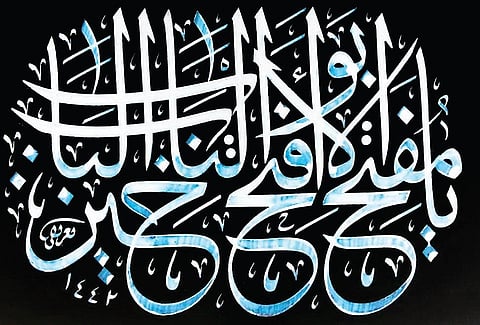

Arabic calligraphy is known to have been introduced during the 6th Century. The earliest Arabic calligraphers would trace verses from the Quran, the sacred text of Islam, with piety in an attempt to preserve the teachings of god or Allah. Khel Gaon resident Qamar Dagar’s love for calligraphy stemmed from her fascination towards the art itself. Born in a family of renowned classical musicians—the Dagar Brothers—she had always been influenced by audio-visual arts, and the rich atmosphere it creates.
Later, Qamar drew inspiration from the works of her spiritual and calligraphy guide Hazrat Amir Abdullah Khan. Khan’s tughras (calligraphic seals in Urdu) helped her understand the simplicity and beauty of the practice. Iraqi painter and calligrapher Hassan Massoudy’s works have also influenced her profoundly. “A lot of people can write neatly or beautifully. Massoudy’s works are not just beautiful, they are inspiring,” Qamar, who is one among the many celebrated calligraphers in India, shares.
More than just letters
Introducing her own abstract style of the art—pictorial calligraphy—Qamar’s works are not just pen strokes on paper but comprise the gamut of what it means to be Hindustani. By juxtaposing Urdu letters with Devanagari ones, her creations are her own understanding of the culture and society that she has been born and brought up in. Not focusing on the languages per se, her works highlight both the unity and the uniqueness of the scripts. “If you go back in time, all the global languages are actually completely abstract.
It is we who gave it name and meaning. These abstract forms are all that matter to me and through them, I am attempting to do something different that makes sense to me,” says the Nari Shakti Award recipient. Speaking about a specific piece titled ‘Anjaam’, she elaborates that while the word in Urdu means culmination, she visualises it as a blossomed flower. Therefore, she uses the letters for the word in both Urdu and Devanagari to visually represent ‘Anjaam’ as a flower in full bloom.
An attempt at revival
In 2010, Qamar founded the Qalamkari Creative Calligraphy Trust, an organisation that works for the revival of the art of calligraphy. A believer of the concept that “art transcends all borders”, she attempts to bring varied languages together as one through her Trust. Qamar aims to establish a space where creative people, who are in awe of global scripts, can converge in order to design works that complement each language while retaining its individuality.
The artists have worked with a number of languages such as Japanese, Arabic, Avestan, Ancient Greek, etc. “There are so many scripts. In this way, these [languages] can be revived and brought to the masses,” mentions Qamar.
She also organises calligraphy workshops. “I do not want people to follow what I am doing. Calligraphy is a form of self-exploration. You can understand yourself through this medium; I feel this is the most beautiful part of the art,” she concludes.